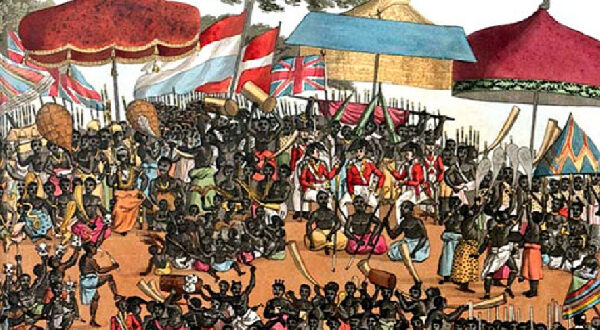It’s almost 200 years since the Battle of Nsamankow, which was fought between the Ashanti Kingdom that occupied what is now southern Ghana and the British.
In that war, during the reign of Ashanti king Osei Tutu Kwame Asibe Bonsu (c. 1801–24), the Ashanti brutally defeated the British, killing a governor on January 21, 1824.
That war would mark the beginning of the over 100 years of battle between the British and the Ashanti people which is today known as the Anglo-Ashanti wars.
But what sparked the war?
History says the Ashanti (or Asante), part of the Akan ethnic group and native to the Ashanti Region of modern-day Ghana, were between the 15th and 19th century having enormous wealth and dominance over trade and lands, as well as, strong warriors who fought to protect their kingdom from both local and foreign threats. The Ashanti Kingdom was then the most revered and powerful Kingdom in the Gold Coast (modern-day Ghana).
By the early 19th century, the British had established themselves well in the Gold Coast and had taken control over the coastal areas winning the trust of the Fanti (or Fante) who had become allies. The Fanti are an Akan people now found in the Central and Western coastal regions of Ghana. The British, despite having control over a great part of the Gold Coast, needed to defeat the Ashanti to weaken their dominance and eventually take over the entire colony.
At the time, a long dispute had existed between the Fanti and Ashanti, and the arrival of the British escalated tensions between the two Akan groups. The Ashanti, which had then proven a force to reckon with, wanted to have access to the coast and control coastal trade. Thus, they frequently raided the Fanti city-states along the coast, extending their attacks to other coastal towns and forts.
In fact, in 1807, Ashanti King Osei Bonsu’s troops attacked the British fort at Anomabo, a coastal town in the Central Region of modern-day Ghana, during a fight with the Fanti. That led to the first face-to-face conference between an Asantehene and a British governor and eventually the first Anglo/Asante trade treaty ratified by Osei Bonsu and the British. Still, the conflicts between the Ashanti and the Fanti continued. The British, by the 1820s, decided to step in to protect the Fanti — who they were then trading with — from the Ashanti.
In late 1823, the first war between the Ashanti and British broke after the then governor, Sir Charles McCarthy, out of frustration, declared war against the Ashanti. This was after the Ashanti had ‘unlawfully’ invaded Fanti lands which were now British protectorates and had refused to settle on an agreement with the British after several demands and discussions. Other sources said the Ashanti were at the time seeking control of the River Pra which was a major trading route for the Fanti. This would lead to the first Anglo-Ashanti war — the Battle of Nsamankow of 1824.
On January 20, 1824, McCarthy led an army of men made up of 80 men of the Royal African Colonial Corps, 170 men of the Cape Coast Militia, and 240 Fanti people under their local chiefs to fight the Ashanti. According to sources, McCarthy’s army was very small compared to Osei Bonsu’s army of over 1000 experienced warriors. Yet, the British assumed they would win the battle due to the advantage of ammunition.
In the end, the British lost. McCarthy’s army reduced in numbers during the war as the Fanti in the army had retreated out of fear. McCarthy himself was killed by an Ashanti warrior and his head was cut off and taken to Kumasi, the Ashanti capital, as a trophy. At the same time, on or around the same day as McCarthy was killed, the Ashanti King, Osei Bonsu, died. Osei Bonsu, according to accounts, “presided over the most sustained expansion of the Asante empire.”

However, the killing of McCarthy and the captivity of his secretary, J. T. Williams, angered the British who sent down troops to establish an army in the Gold Coast and declare war against the Ashanti for the next 100 years. The Ashanti finally became part of the Gold Coast on January 1, 1902, after being defeated in the War of the Golden Stool led by Queen Yaa Asantewaa.
Source: face2faceafrica.com
Disclaimer: MyGhanaMedia is not responsible for this report and its content.There are four types of content published on MyGhanaMedia daily: curated content; syndicated content; user-generated content; and original content.
Send your news stories to myghanamedia@gmail.com and Chat with us via WhatsApp on +233 200818719.
 MYGHANAMEDIA.COM Best Source Of Latest News
MYGHANAMEDIA.COM Best Source Of Latest News




